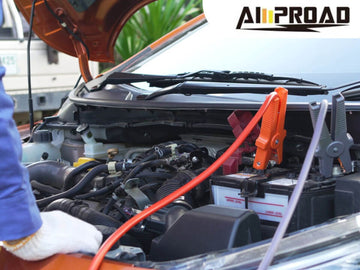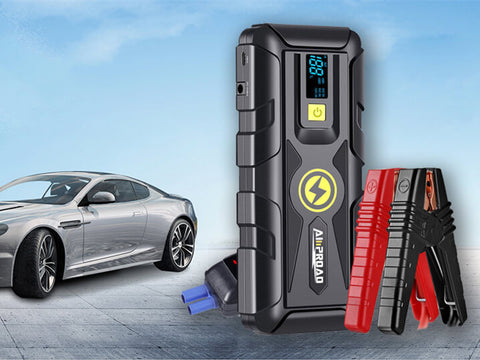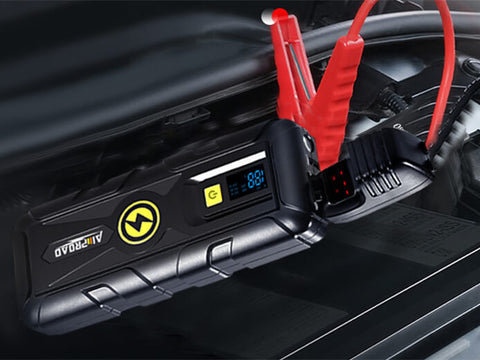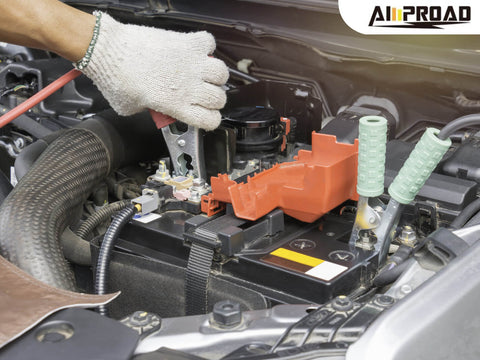
A dead car battery in the middle of nowhere can be a real headache. That's where a portable jump starter comes in - a lifesaver that can jolt your car back to life in minutes. But here's a question: should you keep your jump starter in your car for whenever you need it, or is that risky? Leaving it in the scorching summer heat or freezing winter chills might seem convenient, but could it be dangerous? We'll explore the pros and cons of keeping your jump starter in your car, and offer some safe storage solutions so you're prepared for a dead battery, no matter the situation.
What Safety Concerns Arise with In-Car Storage of Portable Jump Starter?

When it comes to storing a portable jump starter in your car, it's crucial to consider potential safety risks. While portable jump starters are invaluable in emergency situations, improper storage can pose hazards. Here are some safety concerns to keep in mind:
Extreme Temperatures
Extreme temperatures, whether scorching summer heat or freezing winter cold, can have detrimental effects on the battery of a portable jump starter. High temperatures can accelerate chemical reactions within the battery, leading to potential damage and degradation. Conversely, freezing temperatures can cause the battery's electrolyte solution to freeze, rendering the jump starter ineffective. Both scenarios not only compromise the performance of the jump starter but also increase the risk of battery leakage or even explosion.
Direct Sunlight
Exposure to direct sunlight can also pose risks to the integrity and performance of a portable jump starter. Prolonged exposure to UV rays can degrade the materials of the jump starter's casing and components, potentially weakening its structural integrity and reducing its effectiveness. Additionally, excessive heat buildup from direct sunlight can further exacerbate temperature-related issues within the jump starter's battery, hastening degradation and diminishing its ability to hold a charge.
Accidental Damage and Loose Connections
In a vehicle's trunk or storage compartment, a portable jump starter may be susceptible to accidental damage from shifting cargo or rough handling. Impact or pressure on the jump starter could cause internal components to become dislodged or damaged, compromising its functionality and safety. Moreover, loose connections or exposed wiring within the jump starter could increase the risk of a short circuit, potentially leading to overheating, electrical fires, or other hazardous situations.
Ensuring Safe Storage
To mitigate safety risks associated with storing a portable jump starter in your car, consider the following precautions:
- Store the jump starter in a cool, dry place away from direct sunlight, such as the glove compartment or under a seat.
- Inspect the jump starter regularly for signs of damage, corrosion, or loose connections, and address any issues promptly.
- Avoid leaving the jump starter in extreme temperatures for extended periods, particularly during hot summer days or freezing winter nights.
- Follow manufacturer guidelines for proper storage and maintenance of the booster batterie to ensure optimal performance and safety in emergency situations.
By prioritizing safety considerations and implementing proper storage practices, you can ensure that your portable jump starter remains a reliable and effective tool for emergency battery assistance in your vehicle.
How Can You Ensure Safe Storage Strategies?

If you decide to store a portable jump starter in your car for emergencies, it's essential to follow safe storage strategies to minimize potential risks. Here are some tips to help ensure safe in-car storage:
Location Matters
Choose a suitable location in your vehicle for storing the portable jump starter. Opt for a cool, dry spot away from direct sunlight exposure. Avoid areas prone to extreme temperatures, such as the trunk or dashboard, as they can subject the car booster pack to heat buildup or freezing conditions, which may compromise its performance and safety.
Secure the Jump Starter
To prevent movement and potential damage during transit or in the event of sudden stops or turns, securely fasten the jump starter in place. Use Velcro straps, bungee cords, or other secure mounting options to keep the jump starter stable and stationary. Avoid loose storage arrangements that could allow the jump starter to shift or collide with other items in the vehicle, increasing the risk of damage.
Regular Inspection
Perform regular checks on the portable jump starter to ensure its integrity and functionality. Look for any signs of damage, corrosion, or wear on the casing, cables, or connectors. Additionally, check for indications of overheating, such as unusual odors or excessive heat emanating from the unit. If you notice any abnormalities or concerns during inspection, refrain from using the jump starter and address the issue promptly to prevent potential safety hazards.
How to Boost a Car?
It's also essential to familiarize yourself with the proper procedure for using a portable jump starter to boost a car battery in case of emergencies. Here's a simple guide:
- Park both vehicles in a safe location, ensuring they are not in direct contact.
- Turn off the ignition and any electronic devices in both vehicles.
- Connect the positive (+) clamp of the jump starter to the positive terminal of the dead battery.
- Connect the negative (-) clamp of the jump starter to a clean, unpainted metal surface on the vehicle's engine block or chassis, away from the battery.
- Start the vehicle with the charged battery and let it run for a few minutes.
- Attempt to start the vehicle with the dead battery. If successful, disconnect the jump starter in the reverse order of connection.
By implementing these safe storage strategies and familiarizing yourself with how to boost a car using a portable jump starter, you can ensure readiness for any unexpected battery-related emergencies while minimizing associated risks.
How Can You Keep Your Options Open?

For those hesitant about storing a portable jump starter in their car, alternative storage options can provide peace of mind while ensuring readiness for emergencies. Here are some alternative solutions to consider:
Store at Home in a Controlled Environment
If you're reluctant to keep a portable jump starter in your car due to concerns about temperature extremes or potential damage, storing it at home in a controlled environment is a viable option. Find a convenient spot in your garage, utility room, or another indoor area where the battery booster can be easily accessed when needed. Storing the jump starter indoors helps protect it from temperature fluctuations, direct sunlight, and accidental damage, ensuring optimal performance and longevity.
Invest in a Carrying Case for Easy Transport
To maintain the portability and accessibility of a portable jump starter while keeping it out of the car, consider investing in a carrying case or storage bag. These cases are designed to securely hold the jump starter and accessories, providing protection during transport and storage. Look for a case with durable construction, padded compartments, and secure closures to safeguard the jump starter against impacts, dust, and moisture. With a carrying case, you can conveniently store the jump starter in your home or garage and transport it to your vehicle whenever needed, ensuring readiness for emergency battery assistance while minimizing the risk of damage or deterioration.
AMPROAD Versatile Portable Jump Starter
For those seeking a versatile portable jump starter solution, consider the AMPROAD versatile portable jump starter. This innovative device combines the functionality of a jump starter with additional features such as built-in air compressor, USB charging ports, LED flashlight, and emergency signaling capabilities. With its compact and lightweight design, the AMPROAD jump starter is easy to store at home or carry in your vehicle, providing peace of mind and readiness for various emergency situations. Whether you choose to store it in your car or at home, the AMPROAD jump starter offers flexibility and convenience, ensuring you're prepared for unexpected battery-related emergencies wherever you go.
By exploring these alternative storage options and considering the versatility of devices like the AMPROAD portable jump starter, you can find a solution that meets your needs and preferences while ensuring readiness for emergencies on the road.
FAQs / People Also Ask
1. Is it safe to store a portable jump starter in my car?
While storing a portable jump starter in your car can be convenient for emergency situations, it's essential to consider potential safety risks such as extreme temperatures and accidental damage. Following proper storage guidelines, such as avoiding direct sunlight and securing the jump starter to prevent movement, can help minimize risks.
2. What are the benefits of storing a portable jump starter at home?
Storing a portable jump starter at home in a controlled environment offers protection against temperature extremes, direct sunlight exposure, and potential damage. It ensures optimal performance and longevity of the jump starter, ready for use whenever needed.
3. Are carrying cases necessary for portable jump starters?
Carrying cases or storage bags can provide added protection and convenience for transporting and storing portable jump starters. They help safeguard the jump starter against impacts, dust, and moisture, ensuring it remains in good condition and ready for emergency use.
4. Can I use a portable jump starter that has been exposed to extreme temperatures?
Extreme temperatures can affect the performance and safety of a portable jump starter. If the jump starter has been exposed to extreme heat or cold, allow it to return to a moderate temperature before use. Inspect the jump starter for any signs of damage or deterioration before attempting to use it.


